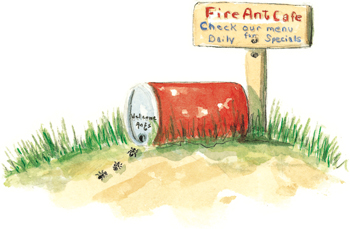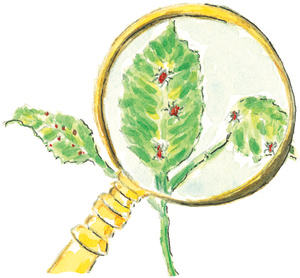
Prowl around in your garden for a few minutes every day to keep in touch with the health of your plants. You’ll be surprised how quickly you begin to notice every tattered edge on insect-damaged leaves or the slightest telltale droop of a besieged bush. Awareness and a quick response are two of your best allies against garden foes.
Sometimes it takes only the shake of a branch, a blast of water, or a dusting of diatomaceous earth to rid your plants of pests. Many of the best and most effective cures available are simple, quick, earth-friendly, and fun to make.

Confuse apple maggots with lookalike apple lures tied with yellow plastic bows. Paint apple-sized rubber balls bright red and hang them with fishing line from apple tree branches. Slather the balls with Stickum Goo (see sidebar for recipe) and tie a broad yellow bow at the top. Brush more goo onto the bow. Remove the balls when they become covered with carcasses, clean with hot water, dry, and refresh the gooey jelly.

Incinerate insect larvae and harmful pathogens that overwinter inside fruits and fallen leaves around fruit trees (especially those with noticeable infestations of scab). Use a commercially available, hand-held propane torch to burn the debris as you walk among your fruit trees.
Sprinkle white flour (not self-rising) on cabbage worms, loopers, and grasshoppers early in the morning when the plants are covered with dew. Pests will literally petrify into desiccated little bug cakes. Rinse off the plants the next day.
Scientists at Texas A&M University estimate that up to 90 percent of problems with aphids, mites, and spittlebug nymphs can be cured with water. A strong blast of water dislodges aphids and breaks off their sucking mouth parts.
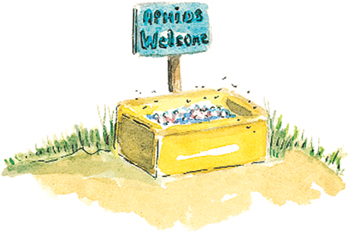
 Did you know that aphids are irresistibly drawn to the color yellow? Set a shallow, yellow pan of soapy water near your infested plants, and the aphids will plunge to a watery end.
Did you know that aphids are irresistibly drawn to the color yellow? Set a shallow, yellow pan of soapy water near your infested plants, and the aphids will plunge to a watery end.
 Order a container of aphid wolves, the larvae of ladybird beetles (see Resources), and release them into your garden. These hungry predators can eat hundreds of aphids a day.
Order a container of aphid wolves, the larvae of ladybird beetles (see Resources), and release them into your garden. These hungry predators can eat hundreds of aphids a day.
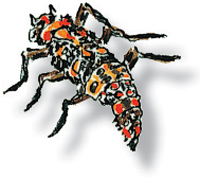
 Use adhesive tape to remove aphids from plant leaves. Wrap a long piece of tape around your fingers (sticky side out), and blot off the aphids.
Use adhesive tape to remove aphids from plant leaves. Wrap a long piece of tape around your fingers (sticky side out), and blot off the aphids.
Caution: Some readers who tried this say it can become habit-forming.
Pluck those dangling baggy webs from your trees, and drop them into hot, soapy water. Each bag, which is disguised with bits and pieces of the host tree, contains a female bagworm—a wingless, eyeless, legless mating machine (pretty attractive, huh?). This means the bag probably also contains as many as 2,000 eggs, each of which will turn into another eating machine.
Some gardeners have had success deterring Japanese beetles by planting a ring of garlic and chives around their rosebushes and potatoes.
These beautiful but devastating pests need no introduction. Get rid of them! Invest in the most important and lethal pair of sandals you’ll ever own. They’re called Lawn Aerator Sandals (see Resources), and they’re one of the best ways to destroy the grubs before they become beetles. After a rain when the grubs surface, slip on a pair of the sandals and dance wildly on your wet lawn.
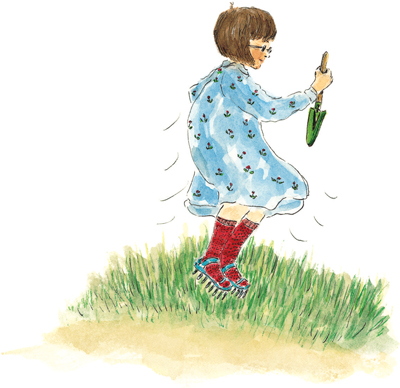
Bounce those bugs right out of your garden with a long-handled spatula or spoon. Go outside early in the morning with your beetle bouncer and a bucket of warm, soapy water. Look for infestations on roses, peonies, and other favorites. Hold the bucket below the bloom and gently whack the flower. The bugs will drop straight down and into your suds. Reuse the soapy water as a spray.

Beetle bouncer
Spread a sheet below foliage infested with cucumber, Japanese, or Colorado potato beetles or squash bugs. Again, go out in the early morning and bounce or shake the insects off the plants and onto the sheet (they’ll instinctively drop straight down). Vacuum or shake the contents of the sheet into a bucket of hot, soapy water. You may need to coax the insects with a stiff-bristled brush; they hold on tightly. (I suggest retiring the sheet after use.)
Arm yourself with a large funnel (or make one by cutting off the bottom of a plastic bottle) and attack cucumber and Japanese beetles and squash bugs early in the morning. Tie a bag to the narrow end of the funnel. Slip the wide mouth of the funnel beneath the infested foliage and shake the plant or blossom. The insects will slide down and into the bag. When finished, tie bag closed and drop it into a trash can.
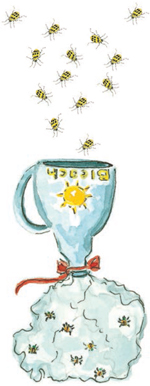
Cucumber and Japanese beetles get trapped in the bag.
Purchase spined soldier bugs, a beetle’s greatest enemy, from an insectary (see Resources) or nursery and set them on patrol in your garden. Purchase beneficial parasitic nematodes (see Resources), mix with water, and apply to a well-watered lawn.
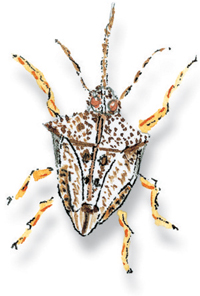
Spined soldier bug
Scientists at the Bio-Integral Research Center in Berkeley devised this method to detect and cure the problem of chinch bugs: Mix 1 ounce liquid soap in a 2-gallon bucket of water. Drench a 2-foot square of lawn with the liquid, let sit 2 or 3 minutes, then cover the entire area with a white flannel blanket. In about half an hour, lift the blanket and check for the chinch bugs, which get tangled in the nap. Rinse the buggy material in a bucket of hot, soapy water.
Drench small areas of buggy lawn with the chinch mixture above, and use a shop vacuum to suck up emerging nymphs. Destroy the contents of the shop vacuum in hot, soapy water.

Wireworms, the larvae of click beetles, feed voraciously on root vegetables such as carrots, beets, turnips, potatoes, and bulbs. Cut a potato into pieces, pierce with a stick, and bury a few inches into the soil, with the stick protruding. Every week, pull up the sticks and destroy the wireworm-infested pieces. Rebait as needed.
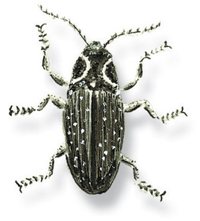
Click beetle
Fool gypsy moths into believing they’ve found the perfect place to lay their eggs. Fold sticky shelf-lining paper in half, sticky side out, and tape it to a tree. Replace the paper after rain, and scrape the moth egg masses beneath the paper into soapy water.
Or use the method touted by Chinese farmers. Attach 8-inch strips of burlap completely around tree trunks. Moth larvae become snagged in the strips and caterpillars congregate in their shelter. Check the strips daily, and drop the critters into soapy water.
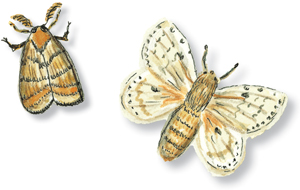
Gypsy moths
Fill an empty cardboard milk carton with crumpled moist newspaper and bread crumbs, and set on its side in your garden. Or crush newspaper into tight balls, moisten with water, and place among the plants.
Pour equal parts canola oil and soy sauce into a shallow container and place in infested areas. Each morning arm yourself with a bucket of soapy water, check the lures, and dispose of the victims.
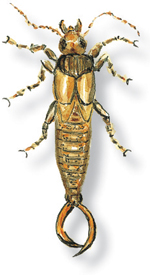
Earwig
Wrap corrugated cardboard around the trunks of fruit trees (corrugated side toward the trunk). The larvae of the codling moth will take shelter underneath to pupate. Remove collars weekly and scrape the larvae into hot, soapy water.
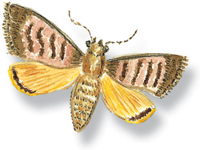
Codling moth
Fight roaches with boric acid. Apply this powerful powder in a light coating, because if you make piles or place it in containers, the roaches will shun it. Use a small-tipped plastic squeeze bottle to shoot the dust into cracks and crevices. As the roaches search for food, the fine powder accumulates on their bodies. When they groom themselves—which these supposedly dirty critters do constantly—they ingest the deadly powder. Keep dry and reapply after rains. Store container and boric acid out of reach of pets and children.
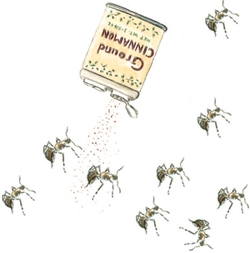
Ants are good soil aerators and food for birds, lizards, and toads, but if you’re determined to eradicate them, use one of these easy solutions:
Spray ant routes with apple cider vinegar to cover their invisible pheromone tracks, so they can’t find their way back to their foraging sites.

Fill a shop vacuum with soapy water and suck large concentrations of ants out of their hiding places.
Pour equal parts baking soda and powdered sugar into a bowl and blend thoroughly. Transfer mixture to a cheese or salt shaker and apply directly to ant hills and trails.
Circle an active ant mound with dry cornmeal. Ants feast on the meal, which expands inside them.

Cinnamon powder acts as a deterrent for ants. Shake it liberally on black ant trails leading into your home or in other areas where you don’t want them.
I never bother ants, but whenever I see an ant path leading into the house, I fill a salt shaker with white sugar and sprinkle it in an enticing trail AWAY from the house.
Silica aerogel or diatomaceous earth injures the protective cuticle covering on the ant’s body and causes desiccation. Shake it into cracks, corners, and holes. Or mix it with sugar and set it out in a peanut butter jar lid.
For plants being farmed by ants, fold sticky shelf-lining paper in half (sticky side out) and strap it around the trunks of fruit trees with duct tape. Change the paper whenever it becomes filled and replace after a rain.
Or set a jar lid of honey at the foot of the tree to attract ants to a sticky demise.
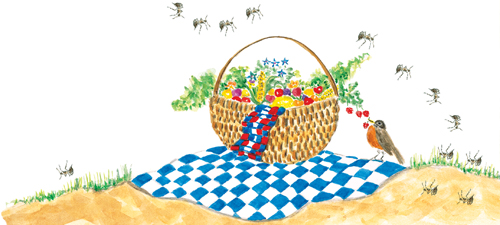

Slugs and snails are responsible for wiping out many a gardener’s dreams. Try some of these successful baits and traps to keep them from your plants.
 Eliminate snail and slug problems by letting a duck roam in your gardens. Ducks are incredible slug and snail hunters, as are toads, raccoons, firefly glowworms, and decollate snails, which are available from beneficial insect suppliers (see Resources).
Eliminate snail and slug problems by letting a duck roam in your gardens. Ducks are incredible slug and snail hunters, as are toads, raccoons, firefly glowworms, and decollate snails, which are available from beneficial insect suppliers (see Resources).
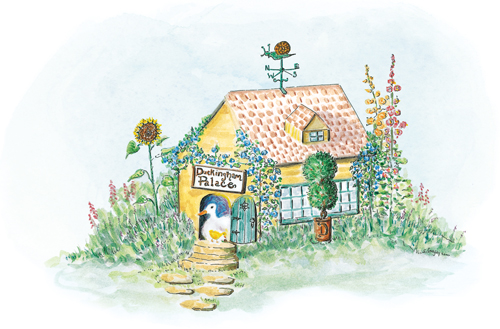
 Leave leftover grapefruit and melon rinds in your yard each evening. Scrape the slugs and snails into soapy water every morning. You’ll need to put out fresh rinds every few days.
Leave leftover grapefruit and melon rinds in your yard each evening. Scrape the slugs and snails into soapy water every morning. You’ll need to put out fresh rinds every few days.
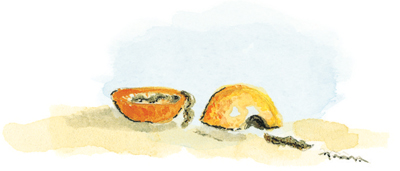
Use grapefruit and melon rinds as lures.
 Water a small portion of your yard in the evening and put down a 1-inch by 12-inch board, elevated slightly on a rock. Early each morning, turn the board over and scrape it clean into soapy water.
Water a small portion of your yard in the evening and put down a 1-inch by 12-inch board, elevated slightly on a rock. Early each morning, turn the board over and scrape it clean into soapy water.
 Lay empty flowerpots (or milk cartons) on their sides in a shady area and dispose of slugs and snails every morning.
Lay empty flowerpots (or milk cartons) on their sides in a shady area and dispose of slugs and snails every morning.
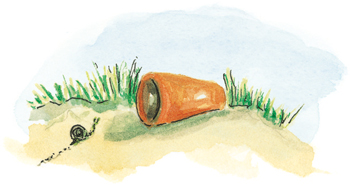
Slugs will collect in empty flowerpots.
 Sprinkle bran or yeast onto cabbage leaves and set in a shaded, moist area. Collect and dispose of leaves daily.
Sprinkle bran or yeast onto cabbage leaves and set in a shaded, moist area. Collect and dispose of leaves daily.
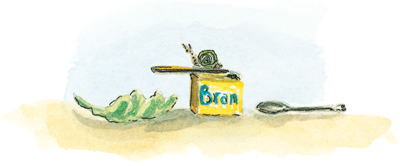
Sprinkle bran or yeast on cabbage leaves.
 Sink shallow tubs or saucers into the ground and fill them with cheap beer (slugs and snails aren’t too particular) or molasses and a sprinkling of yeast. They dive into it and drown. Empty as needed.
Sink shallow tubs or saucers into the ground and fill them with cheap beer (slugs and snails aren’t too particular) or molasses and a sprinkling of yeast. They dive into it and drown. Empty as needed.

Slugs are drawn to beer for a happy ending.
Fire ants are one of the most destructive and dangerous pests found in a garden, causing damage to over fifty species of plants and killing native ants and many species of mammals, reptiles, amphibians, and birds. Their painful sting can cause serious allergic reactions in humans as well.
Always wear long pants, tuck them into your boots, and tie or rubber-band them closed. Dust boots and legs with baby powder or cornstarch to make them slippery. Work quickly and quietly so as not to alert the queen. Plan your attack for a sunny but cool day. Ants will be close to the surface of the mound, and the queen will be on the sunny side.

No single cure will always work for fire ants, so try a variety of strategies:
Dust the soil around the ant mound with a wide circle of diatomaceous earth. The ants may have foraging tunnels in various areas.
Researchers at Florida State University successfully treated active mounds with boiling water. Use caution, and pour 3 gallons of hot water (194 degrees) onto the mound. Break up crusted soil (before watering.) Repeat process for three days.
In the winter, attack mounds when temperatures drop to near freezing to expose the ants to cold. Use a broad beam of wood or a landscaping rake to totally level the mound.

The Bio-Integral Resource Center recommends a sweet bait made of 1 teaspoon boric acid and 10 teaspoons granulated sugar in 2 cups water. Stir thoroughly and pour into lidded containers pierced with ant-sized entry holes.
Apply the bait during the dry days of spring, summer, and fall. Set cans about 5 feet away from the mounds.
On days over 95 degrees, set your bait can out in the cool evening; lay it on its side in an area where ants forage.
Don’t put the cans directly on the mound or the foragers won’t find them; place them about 5 feet away.
If water gets into the baits, they won’t work.
Always keep from children and pets.
